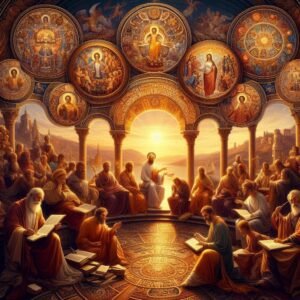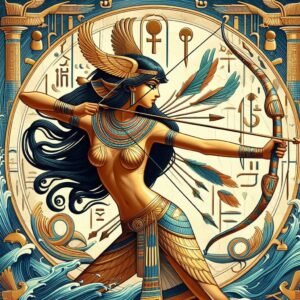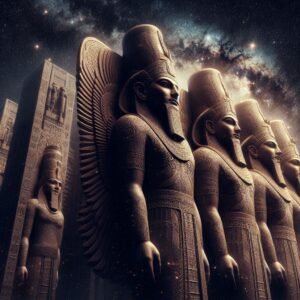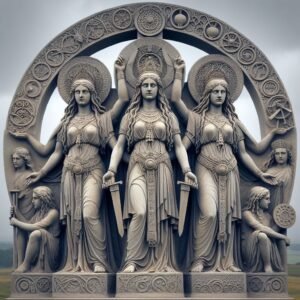
Note: This is a work in progress. Only the A’s have been covered so far.
The concept of heaven is a multifaceted one, deeply embedded in the human psyche and manifesting across various cultures and religions, each offering a unique perspective that mirrors their core values and ultimate aspirations. In Christianity, heaven is seen as the dwelling place of God and his angels, a realm of eternal bliss and the reward for a righteous life. This aligns with the Christian doctrine of salvation and the afterlife, where heaven is the final destination for the souls of the faithful. Similarly, in ancient Mesopotamian belief systems, heaven was structured in multiple layers, reflecting a complex cosmology of the universe and the afterlife.
In many Eastern philosophies, however, the concept of heaven is not necessarily a distinct external place but rather an internal state of enlightenment and peace. This introspective view sees heaven and hell as conditions of the mind, with one’s actions and consciousness being the ultimate judge. This contrasts with the Western externalization of these realms, where heaven and hell are often seen as separate from the earthly plane.
The diversity in the conceptualization of heaven can also be seen in the rich tapestry of mythologies and religious texts. For instance, Dante’s “The Divine Comedy” illustrates a journey through hell, purgatory, and finally paradise, symbolizing the soul’s ascent to a state of divine grace. This allegorical representation underscores the belief in a transformative spiritual journey post-mortem, which is a common thread in many religious narratives.
Moreover, the depiction of heaven often serves as a reflection of a society’s ideals and virtues. It is a projection of the ultimate peace, abundance, and happiness that humans strive for, transcending the limitations and sufferings of the mortal world. In this sense, heaven is not just a promised reward but also a motivational force, inspiring individuals to lead lives of virtue and purpose.
The concept of heaven also carries with it the implication of order and structure, as seen in many ancient cosmologies where heaven is the blueprint for creation and the standard for beauty and truth. This celestial order is often mirrored in the governance and societal organization, suggesting a divine mandate for rulers and a cosmic balance that influences earthly affairs.
In summary, the concept of heaven is a complex and layered one, varying significantly across different cultural and religious landscapes. It encapsulates the deepest human desires for harmony, fulfilment, and understanding of the universe. The rich variety of interpretations of heaven speaks to the universal human quest for meaning and the hope for a transcendent existence beyond the physical life. These interpretations, grounded in religious texts, mythologies, and philosophical discourses, continue to influence the moral and ethical frameworks of societies around the world. References to source literature, such as the works of Dante and the religious texts of Christianity and ancient Mesopotamia, provide a more profound insight into the historical and cultural contexts of these beliefs.
Cultural interpretations of heaven are as diverse as the societies that conceptualize them, each reflecting unique cosmologies and spiritual aspirations. In many African traditions, heaven is not seen as a final destination but rather a continuation of life in another realm, where ancestors play a significant role in guiding and protecting the living. This view emphasizes the interconnectedness of life and death, and the ongoing influence of those who have passed on.
In Hinduism, heaven, known as Svarga, is a temporary place of rest and enjoyment for the soul before it moves on to its next incarnation. The ultimate goal, however, is not to remain in heaven but to achieve Moksha, liberation from the cycle of birth and rebirth. Similarly, in Buddhism, heaven (or the various heavens) is seen as a place of temporary respite, where beings enjoy the fruits of their good karma until they are reborn. The ultimate aim here too is enlightenment, or Nirvana, which transcends the cycle of samsara, or suffering.
The ancient Egyptians envisioned the afterlife as a mirror of their earthly life, a Field of Reeds where one could continue their daily activities without the pain or strife of the mortal world. To reach this paradise, one’s heart had to be lighter than a feather, symbolizing a life lived with Ma’at, or truth and balance.
In Norse mythology, Valhalla is perhaps the most famous of the heavens, a hall where warriors slain in battle are gathered by the god Odin. They feast and fight until the end of days, when they will join the gods in the final battle, Ragnarök. This reflects the valorization of bravery and strength in Norse culture.
The indigenous peoples of North America have varied beliefs, but many see the afterlife as a continuation of the natural world, with an emphasis on harmony with nature and the continuation of community ties. This perspective highlights the importance of the environment and the collective over the individual.
In contemporary popular culture, heaven is often depicted as a place of personal fulfilment and happiness, reflecting modern values of individualism and self-realization. This can be seen in films, literature, and music, where heaven is portrayed as a place where one’s dreams come true, and loved ones are reunited.
These cultural interpretations of heaven provide a window into the values and beliefs of different societies. They offer insights into how humans across time and space have grappled with the mysteries of existence and sought hope and meaning in the concept of an afterlife. Whether as a place of rest and enjoyment, a state of enlightenment, or a continuation of life’s journey, heaven remains a powerful symbol of humanity’s deepest aspirations and enduring quest for transcendence.

Aaru
In ancient Egyptian mythology, Aaru, also known as the Field of Reeds, was envisioned as a paradisiacal realm where souls deemed worthy could dwell in an eternal afterlife of peace and contentment. This celestial domain was ruled by Osiris, the god of the afterlife, and was often depicted as a mirror of the Nile Delta, abundant with lush reed fields, which symbolized fertility and rebirth. The journey to Aaru was not an easy one; it was believed that the deceased had to traverse a perilous landscape, facing challenges and judgment before reaching this idyllic destination.
The concept of Aaru was deeply intertwined with the Egyptian belief in Maat, the principle of truth, balance, and order. The heart of the deceased was weighed against the feather of Maat in a ritual known as the Weighing of the Heart. If the heart was found to be as light as the feather, the soul was granted passage to Aaru; if not, it was devoured by Ammit, the demoness, and condemned to oblivion. This process underscored the Egyptian value system, where moral integrity and virtuous living were prerequisites for a favourable afterlife.
Aaru was described as a series of islands amidst boundless reed fields, where the souls of the righteous could engage in activities they enjoyed during their earthly life, such as farming, fishing, and hunting, thus continuing their existence in a manner akin to their earthly lives but without the hardships. The inhabitants of Aaru were also in the company of the gods, living in a state of perpetual harmony and divine fellowship.
The depictions of Aaru can be found in various funerary texts, such as the Book of the Dead, which includes spells and incantations to aid the deceased in navigating the afterlife and reaching Aaru. The Papyrus of Ani, housed in the British Museum, provides a vivid illustration of the Field of Reeds, showcasing the idealized afterlife that awaited the virtuous souls. These texts not only offer insights into the Egyptian vision of the afterlife but also reflect the cultural and religious values of ancient Egyptian society.
Aaru or the Field of Reeds was a central element of ancient Egyptian eschatology, representing the ultimate reward for a life well-lived according to the principles of Maat. It was a place of eternal joy and abundance, where the soul could find rest and fulfilment after successfully completing its earthly and post-mortem journeys. The rich iconography and literature surrounding Aaru continue to fascinate scholars and laypersons alike, providing a window into the ancient Egyptian world-view and its profound appreciation for the afterlife.

Asgard
Asgard, in Norse mythology, is a celestial fortress and the exalted realm where the Aesir, a principal pantheon of gods, reside. This divine abode is often depicted as a majestic, idyllic place, elevated above the human world of Midgard. It is said to be accessible only via Bifrost, the rainbow bridge, guarded by the god Heimdall. Asgard is not just one place but a complex of palatial estates and halls, each belonging to different gods. The most renowned of these is Valhalla, the hall of the slain, presided over by Odin, the Allfather and chief of the Aesir. Here, warriors who died heroically in battle are brought by the Valkyries to live and prepare for the events of Ragnarök, the end of the world in Norse eschatology.
The literary sources for our knowledge of Asgard are primarily the Poetic Edda and the Prose Edda, collections of poems and tales compiled from earlier traditional sources. The Poetic Edda, a compilation of Old Norse poems from the Icelandic mediaeval manuscript Codex Regius, provides a vivid portrayal of the Norse cosmology, including Asgard. The Prose Edda, written by the Icelandic scholar Snorri Sturluson in the 13th century, offers a more systematic and detailed account of Norse myths, including the creation and description of Asgard and its inhabitants. Snorri’s work draws on earlier sources, such as the Poetic Edda, and is invaluable for understanding the pre-Christian beliefs of the Norse people.
In these texts, Asgard is described as divided into various realms. For instance, Valhalla is Odin’s hall, while Thrudheim is the realm of Thor, the god of thunder, and Breidablik is the home of Balder, the god of light. Each realm within Asgard reflects the characteristics and domains of its respective deity. The concept of Asgard bears similarities to other mythological paradises, such as the Greek Mount Olympus, and serves as a symbol of divine power and order.
The sagas also recount the activities and lives of the gods within Asgard, their interactions with other realms such as Jotunheim, the land of the giants, and their eventual fate at Ragnarök. The imagery associated with Asgard is rich and varied, often involving gold and precious materials, signifying its otherworldly splendour and the high status of its divine inhabitants.
For those interested in delving deeper into the mythological sources, the Poetic Edda and the Prose Edda are essential readings. They describe Asgard and its divine residents and offer insights into the values and world-view of the Norse culture. The sagas contained within these works, such as the Volsunga Saga and the Heimskringla, also provide context and narrative to the mythological framework, enriching the tapestry of Norse mythology and its pantheon of gods and heroes.
Valhalla holds a central place in Norse mythology as the hall of the slain, where warriors who died in battle are brought to live in eternal glory. According to the mythos, these warriors, known as Einherjar, are chosen by Odin, the chief of the Aesir and ruler of Asgard, to reside in Valhalla until the time of Ragnarök. This majestic hall is described as a vast palace with a roof made of shields, symbolizing the valour and protection of the warriors within. The Einherjar spend their days in combat training for the final battle at the end of the world, and their nights feasting on the flesh of a boar that is magically restored to life each day, and drinking mead provided by the goat Heidrun, which flows from its udders.
Valhalla’s significance extends beyond its role as a warrior’s paradise; it embodies the Norse cultural values of bravery, honour, and the heroic pursuit of glory. The concept of Valhalla also served to ease the fear of death in battle, offering a noble and desirable afterlife for those who fell while fighting courageously. The hall’s daily cycle of fighting and feasting reflects the Norse belief in the importance of preparation and camaraderie among warriors. The idea that the Einherjar will leave Valhalla to fight alongside the gods during Ragnarök illustrates the interconnectedness of fate and destiny in Norse cosmology.
The sources of our knowledge about Valhalla, such as the Poetic Edda and the Prose Edda, provide rich descriptions and narratives that have captivated the imagination for centuries. These texts, along with sagas like the Volsunga Saga and Heimskringla, offer a window into the beliefs and storytelling traditions of the Norse people. Valhalla’s influence can be seen in various aspects of modern culture, from literature and art to popular media, where it often represents an idealized afterlife for heroes.
In summary, Valhalla is not just a mythical location but a powerful symbol of the Norse ethos. It stands as a testament to the enduring legacy of the Norsemen and their world-view, which continues to inspire and intrigue people around the world.

Akshardham
In Hinduism, ‘Akshardham’ is revered as the divine abode of God, a sanctified place that represents the ultimate pilgrimage for the soul’s journey towards spiritual enlightenment and unity with the divine. The term ‘Akshardham’ combines two Sanskrit words: ‘Akshar’, meaning imperishable or eternal, and ‘Dham’, meaning abode or home. Thus, Akshardham signifies the eternal dwelling of the Supreme Being, where the soul aspires to reach in its purest form, free from the cycle of birth, death, and rebirth. This concept is deeply rooted in Hindu philosophy and is vividly described in various scriptures.
The Swaminarayan tradition, a denomination within Hinduism, holds the term ‘Akshardham’ in high regard, believing it to be the celestial home of their deity, Swaminarayan. According to their beliefs, Akshardham is the place where Swaminarayan resides in his divine form, along with other liberated souls and celestial beings. It is a place of infinite bliss and beauty, beyond the comprehension of the mortal mind, and is often depicted in literature and art as a magnificent and opulent realm.
The physical manifestations of Akshardham, such as the grand temples found in Delhi and New Jersey, are architectural marvels that aim to encapsulate the grandeur and sanctity of the divine abode. These temples serve as earthly replicas of the celestial Akshardham, providing a space for devotees to worship, meditate, and experience a connection with the divine. The intricate carvings, statues, and exhibitions within these complexes are designed to narrate the teachings of Hinduism, the life of Swaminarayan, and the path to spiritual perfection.
The Akshardham temple in Delhi, for instance, is not just a place of worship but a cultural and spiritual campus that showcases millennia of Hindu culture, spirituality, and architecture. It was inspired by Yogiji Maharaj and created by Pramukh Swami Maharaj, constructed by the Bochasanwasi Akshar Purushottam Swaminarayan Sanstha (BAPS). The temple stands as a testament to the ancient Vastu shastra and Pancharatra shastra, embodying the principles of sacred architecture that are believed to resonate with the cosmic structure of Akshardham itself.
The philosophy of Akshardham and its representation in Hinduism is further enriched by the narratives found in sacred texts such as the Vedas and the epics like the Ramayana and Mahabharata. These scriptures often illustrate the virtues and glories of the divine abode, guiding devotees on how to lead a life that aligns with the divine principles and brings them closer to Akshardham.
Akshardham in Hinduism symbolizes the ultimate destination of the soul, a divine realm where God resides and where devotees aspire to reach through devotion, good deeds, and spiritual practice. The physical temples named Akshardham are more than just structures; they are embodiments of Hindu teachings, a place where stories and philosophies are brought to life, inspiring individuals to embark on their spiritual journey towards the eternal abode.
These concepts of heaven share common themes of reward, peace, and an existence beyond the mortal realm, each providing a unique perspective on the afterlife and the soul’s journey after death.









Truth of Self › Forums › The Heavens – A to Z
Tagged: A to Z, Aaru, akshardham, Asgard, field of reeds, heaven, heavens